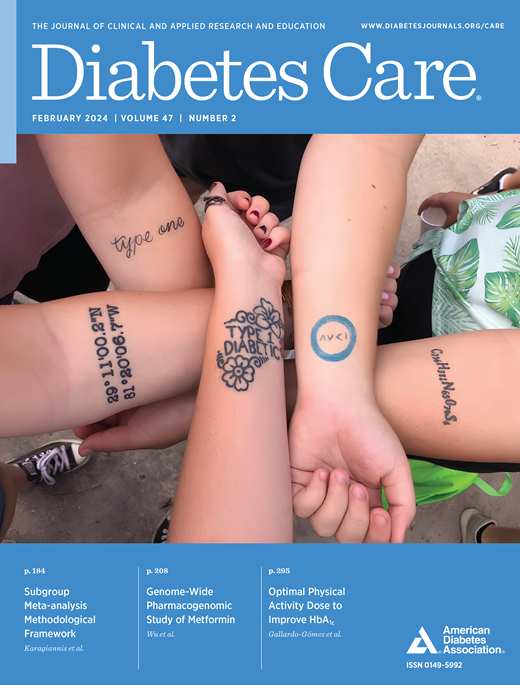Cardiovascular Complications, Kidney Failure, and Mortality in Young-Onset Type 1 and 2 Diabetes: Data From the Korean National Health Insurance Service
IF 14.8
1区 医学
Q1 ENDOCRINOLOGY & METABOLISM
引用次数: 0
Abstract
OBJECTIVE To explore all-cause mortality and the incidence of cardiovascular and renal complications among patients with young-onset diabetes in South Korea using a nationwide registry database. RESEARCH DESIGN AND METHODS Data were collected from the Korean National Health Insurance Service–National Sample Cohort database from 2006 to 2019 for patients aged ≤30 years with type 1 (T1D) or 2 diabetes (T2D). The incidence rates of cardiovascular complications (myocardial infarction [MI] and stroke) and kidney failure, as well as all-cause mortality, were compared with those in the general population. RESULTS This study included 513,633 participants, comprising 413 with T1D, 1,250 with T2D, and 511,970 controls. After adjusting for sex, age, family income, hypertension, and dyslipidemia, the hazard ratio (HR) for MI was 6.76 (95% CI 2.44–18.72) and 5.07 (95% CI 2.48–10.36) for T1D and T2D, respectively. The HR for stroke was 4.65 (95% CI 1.70–12.71) and 3.30 (95% CI 1.67–6.53) for T1D and T2D, respectively. The HR for kidney failure was 20.92 (95% CI 11.40–38.39) and 2.78 (95% CI 1.37–5.64) for T1D and T2D, respectively. The mortality risk was significantly higher in patients with T1D (3.69; 95% CI 1.95–6.98) and T2D (3.06; 95% CI 2.02–4.63) than in the control group. The mortality risk was highest in the T2D subgroup of participants aged <20 years at enrollment (10.70; 95% CI 4.41–25.94). CONCLUSIONS In South Korea, patients with young-onset diabetes are at high risk of cardiovascular complications, kidney failure, and death.心血管并发症、肾衰竭和年轻发病1型和2型糖尿病的死亡率:来自韩国国民健康保险服务的数据
目的:利用一个全国性的登记数据库,探讨韩国年轻发病糖尿病患者的全因死亡率和心血管及肾脏并发症发生率。研究设计和方法从2006年至2019年韩国国民健康保险服务国家样本队列数据库中收集年龄≤30岁的1型(T1D)或2型糖尿病(T2D)患者的数据。心血管并发症(心肌梗死[MI]和中风)和肾衰竭的发生率以及全因死亡率与普通人群进行比较。结果:本研究纳入513,633名参与者,其中413名T1D患者,1,250名T2D患者和511,970名对照组。在调整性别、年龄、家庭收入、高血压和血脂异常等因素后,T1D和T2D的MI风险比(HR)分别为6.76 (95% CI 2.44-18.72)和5.07 (95% CI 2.48-10.36)。T1D和T2D的卒中HR分别为4.65 (95% CI 1.70-12.71)和3.30 (95% CI 1.67-6.53)。T1D和T2D肾衰竭的HR分别为20.92 (95% CI 11.40-38.39)和2.78 (95% CI 1.37-5.64)。T1D患者的死亡风险明显更高(3.69;95% CI 1.95-6.98)和T2D (3.06;95% CI 2.02-4.63)。T2D亚组的死亡风险最高,受试者入组时年龄为18 ~ 20岁(10.70;95% ci 4.41-25.94)。结论:在韩国,年轻发病的糖尿病患者心血管并发症、肾衰竭和死亡的风险较高。
本文章由计算机程序翻译,如有差异,请以英文原文为准。
求助全文
约1分钟内获得全文
求助全文
来源期刊

Diabetes Care
医学-内分泌学与代谢
CiteScore
27.80
自引率
4.90%
发文量
449
审稿时长
1 months
期刊介绍:
The journal's overarching mission can be captured by the simple word "Care," reflecting its commitment to enhancing patient well-being. Diabetes Care aims to support better patient care by addressing the comprehensive needs of healthcare professionals dedicated to managing diabetes.
Diabetes Care serves as a valuable resource for healthcare practitioners, aiming to advance knowledge, foster research, and improve diabetes management. The journal publishes original research across various categories, including Clinical Care, Education, Nutrition, Psychosocial Research, Epidemiology, Health Services Research, Emerging Treatments and Technologies, Pathophysiology, Complications, and Cardiovascular and Metabolic Risk. Additionally, Diabetes Care features ADA statements, consensus reports, review articles, letters to the editor, and health/medical news, appealing to a diverse audience of physicians, researchers, psychologists, educators, and other healthcare professionals.
 求助内容:
求助内容: 应助结果提醒方式:
应助结果提醒方式:


